Report on Race Discrimination in the Workplace for BME Firm
VerifiedAdded on 2021/06/18
|23
|5779
|83
Report
AI Summary
This report provides an in-depth analysis of race discrimination in the UK construction industry, focusing on the experiences of ethnic minority employees and the role of the human resource manager. The report explores the historical context of racial inequality, the nature and scale of discrimination, and the barriers faced by minority groups in recruitment, training, and progression. It examines the impact of discrimination on workplace outcomes and highlights the importance of equality and diversity policies. The report also considers the specific challenges faced by the BME construction consulting firm, BME, and provides recommendations for creating a more inclusive and equitable workplace, including strategies for promoting gender equality and addressing issues of underrepresentation. The report concludes with suggestions for future research and outlines key issues and courses of action to combat racial discrimination and promote fairness within the construction sector.
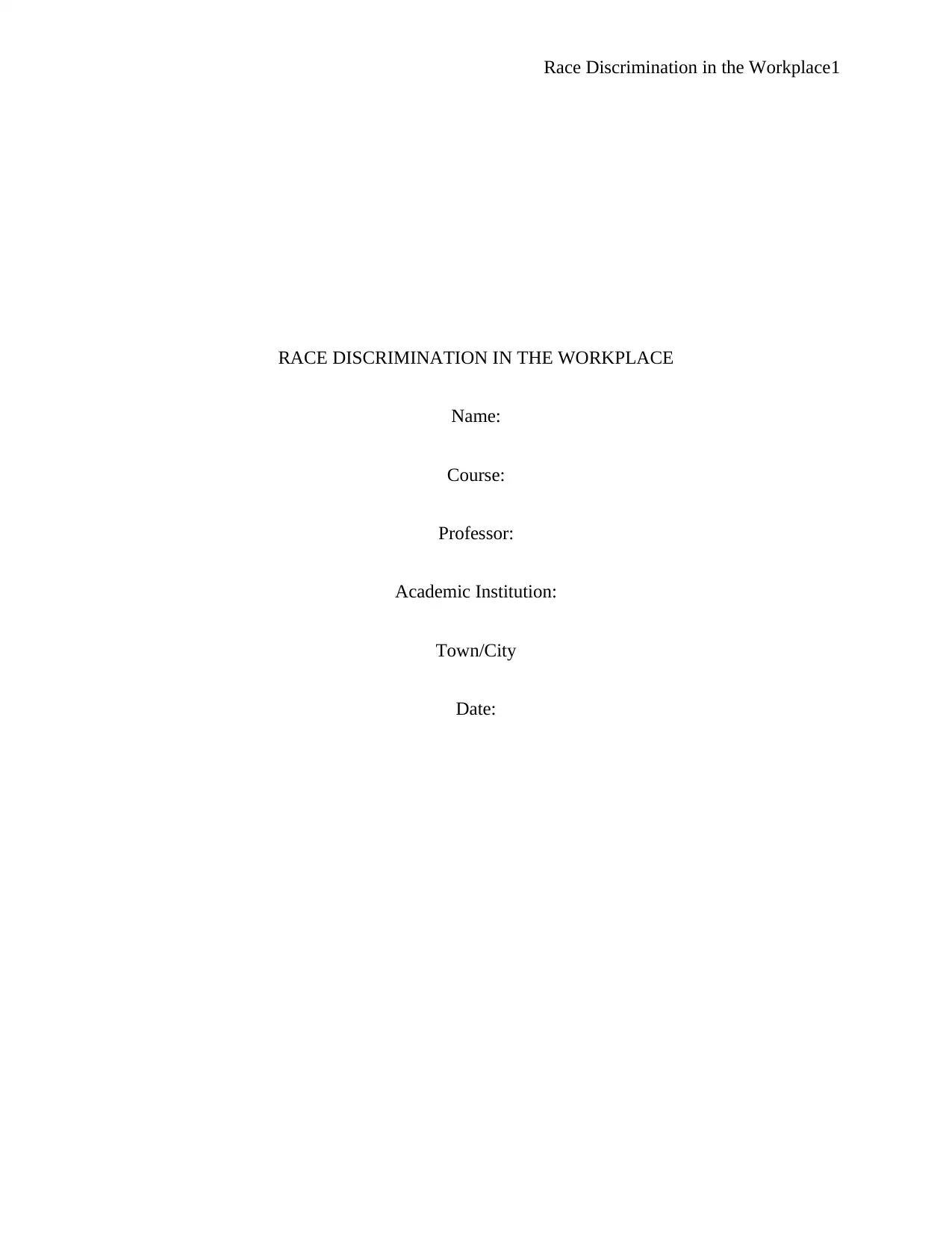
Race Discrimination in the Workplace1
RACE DISCRIMINATION IN THE WORKPLACE
Name:
Course:
Professor:
Academic Institution:
Town/City
Date:
RACE DISCRIMINATION IN THE WORKPLACE
Name:
Course:
Professor:
Academic Institution:
Town/City
Date:
Paraphrase This Document
Need a fresh take? Get an instant paraphrase of this document with our AI Paraphraser
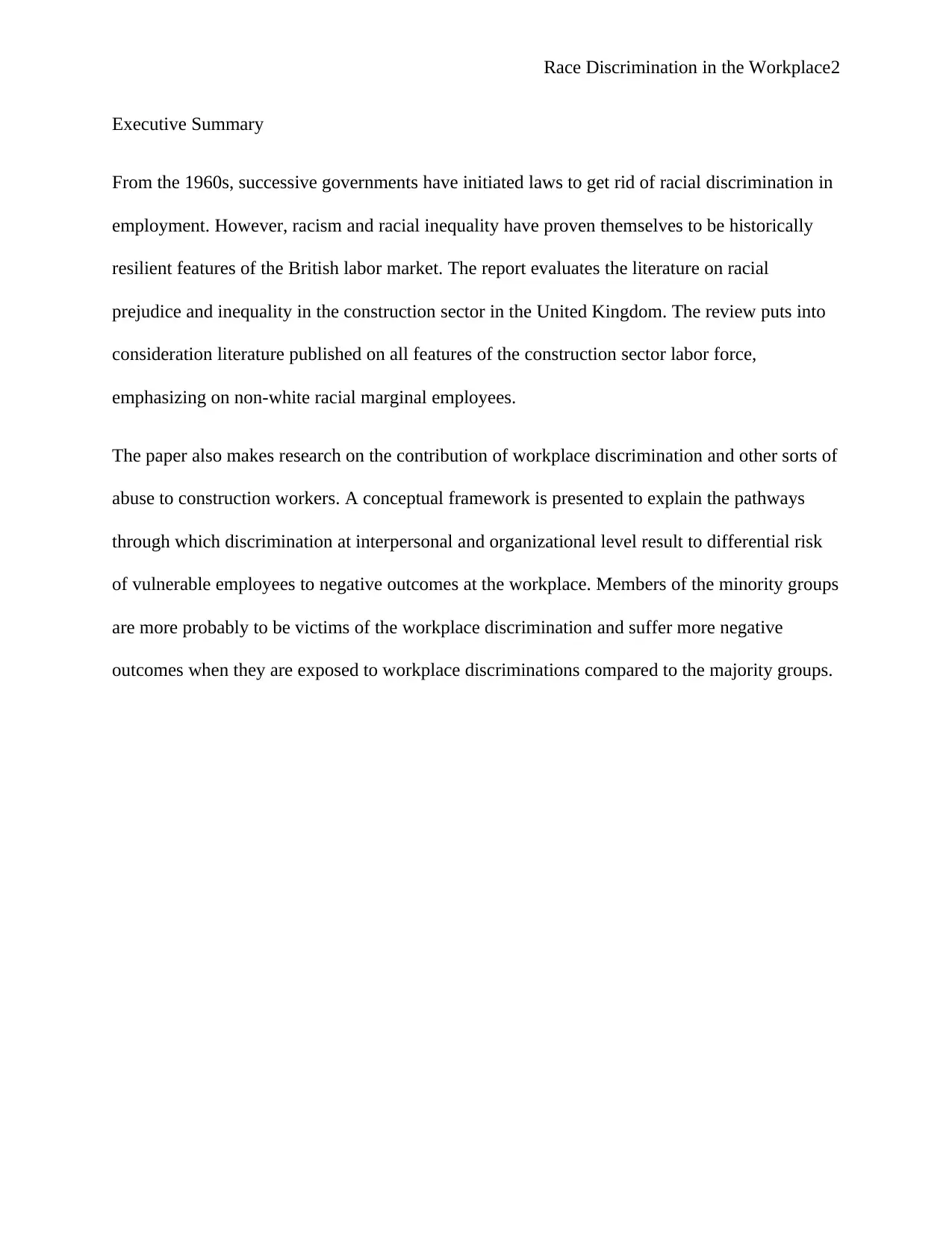
Race Discrimination in the Workplace2
Executive Summary
From the 1960s, successive governments have initiated laws to get rid of racial discrimination in
employment. However, racism and racial inequality have proven themselves to be historically
resilient features of the British labor market. The report evaluates the literature on racial
prejudice and inequality in the construction sector in the United Kingdom. The review puts into
consideration literature published on all features of the construction sector labor force,
emphasizing on non-white racial marginal employees.
The paper also makes research on the contribution of workplace discrimination and other sorts of
abuse to construction workers. A conceptual framework is presented to explain the pathways
through which discrimination at interpersonal and organizational level result to differential risk
of vulnerable employees to negative outcomes at the workplace. Members of the minority groups
are more probably to be victims of the workplace discrimination and suffer more negative
outcomes when they are exposed to workplace discriminations compared to the majority groups.
Executive Summary
From the 1960s, successive governments have initiated laws to get rid of racial discrimination in
employment. However, racism and racial inequality have proven themselves to be historically
resilient features of the British labor market. The report evaluates the literature on racial
prejudice and inequality in the construction sector in the United Kingdom. The review puts into
consideration literature published on all features of the construction sector labor force,
emphasizing on non-white racial marginal employees.
The paper also makes research on the contribution of workplace discrimination and other sorts of
abuse to construction workers. A conceptual framework is presented to explain the pathways
through which discrimination at interpersonal and organizational level result to differential risk
of vulnerable employees to negative outcomes at the workplace. Members of the minority groups
are more probably to be victims of the workplace discrimination and suffer more negative
outcomes when they are exposed to workplace discriminations compared to the majority groups.
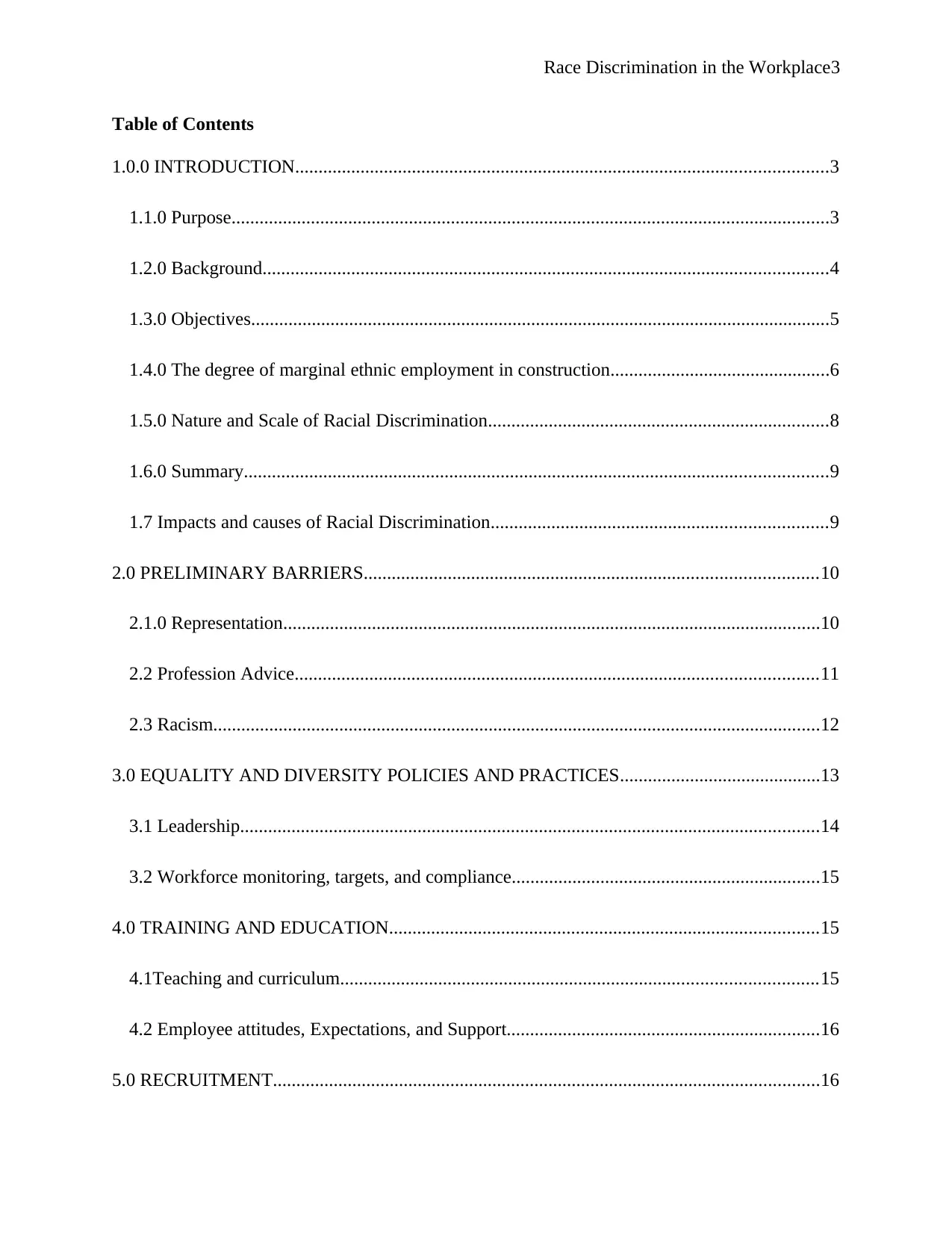
Race Discrimination in the Workplace3
Table of Contents
1.0.0 INTRODUCTION..................................................................................................................3
1.1.0 Purpose................................................................................................................................3
1.2.0 Background.........................................................................................................................4
1.3.0 Objectives............................................................................................................................5
1.4.0 The degree of marginal ethnic employment in construction...............................................6
1.5.0 Nature and Scale of Racial Discrimination.........................................................................8
1.6.0 Summary.............................................................................................................................9
1.7 Impacts and causes of Racial Discrimination........................................................................9
2.0 PRELIMINARY BARRIERS.................................................................................................10
2.1.0 Representation...................................................................................................................10
2.2 Profession Advice................................................................................................................11
2.3 Racism..................................................................................................................................12
3.0 EQUALITY AND DIVERSITY POLICIES AND PRACTICES...........................................13
3.1 Leadership............................................................................................................................14
3.2 Workforce monitoring, targets, and compliance..................................................................15
4.0 TRAINING AND EDUCATION............................................................................................15
4.1Teaching and curriculum......................................................................................................15
4.2 Employee attitudes, Expectations, and Support...................................................................16
5.0 RECRUITMENT.....................................................................................................................16
Table of Contents
1.0.0 INTRODUCTION..................................................................................................................3
1.1.0 Purpose................................................................................................................................3
1.2.0 Background.........................................................................................................................4
1.3.0 Objectives............................................................................................................................5
1.4.0 The degree of marginal ethnic employment in construction...............................................6
1.5.0 Nature and Scale of Racial Discrimination.........................................................................8
1.6.0 Summary.............................................................................................................................9
1.7 Impacts and causes of Racial Discrimination........................................................................9
2.0 PRELIMINARY BARRIERS.................................................................................................10
2.1.0 Representation...................................................................................................................10
2.2 Profession Advice................................................................................................................11
2.3 Racism..................................................................................................................................12
3.0 EQUALITY AND DIVERSITY POLICIES AND PRACTICES...........................................13
3.1 Leadership............................................................................................................................14
3.2 Workforce monitoring, targets, and compliance..................................................................15
4.0 TRAINING AND EDUCATION............................................................................................15
4.1Teaching and curriculum......................................................................................................15
4.2 Employee attitudes, Expectations, and Support...................................................................16
5.0 RECRUITMENT.....................................................................................................................16
⊘ This is a preview!⊘
Do you want full access?
Subscribe today to unlock all pages.

Trusted by 1+ million students worldwide
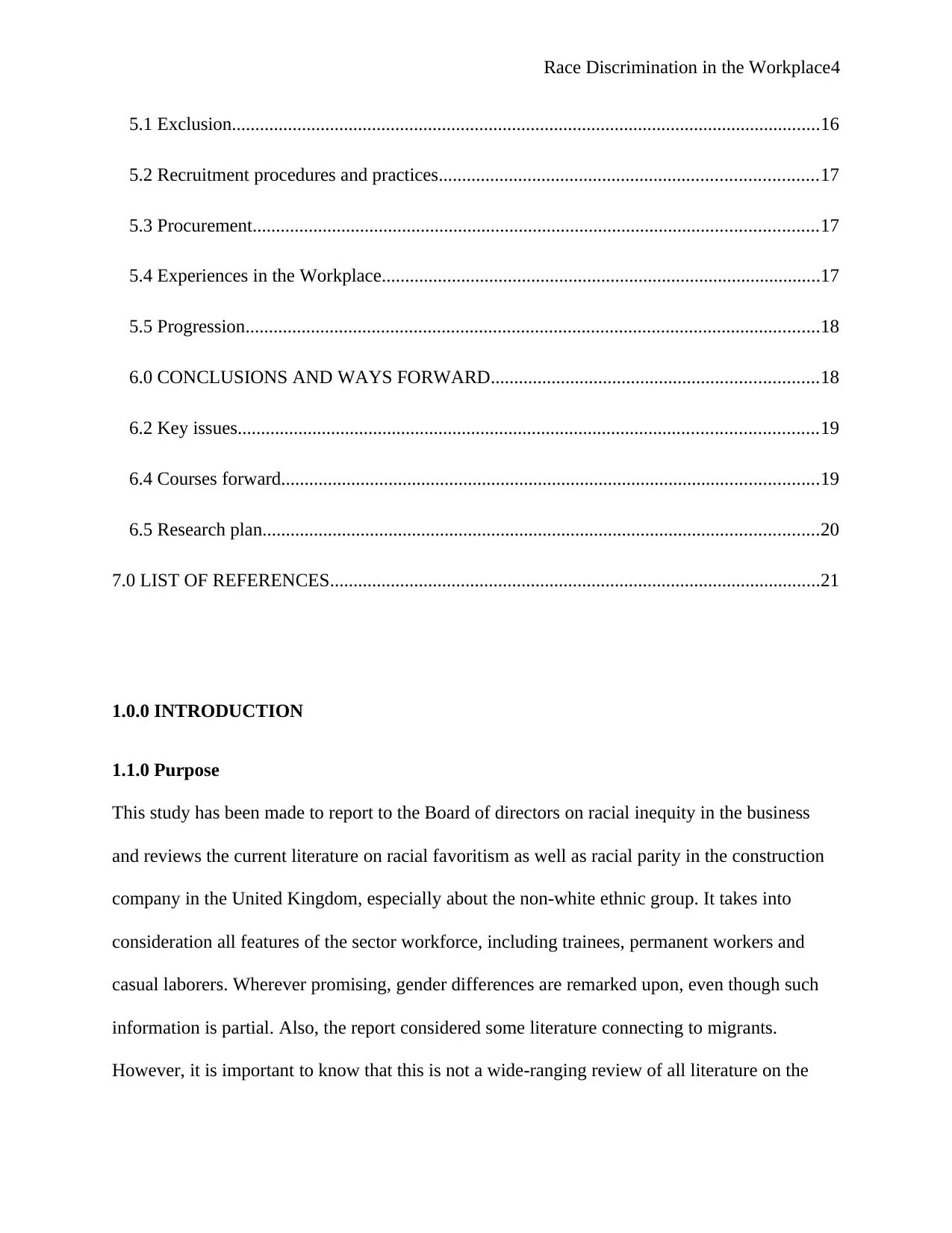
Race Discrimination in the Workplace4
5.1 Exclusion..............................................................................................................................16
5.2 Recruitment procedures and practices.................................................................................17
5.3 Procurement.........................................................................................................................17
5.4 Experiences in the Workplace..............................................................................................17
5.5 Progression...........................................................................................................................18
6.0 CONCLUSIONS AND WAYS FORWARD......................................................................18
6.2 Key issues............................................................................................................................19
6.4 Courses forward...................................................................................................................19
6.5 Research plan.......................................................................................................................20
7.0 LIST OF REFERENCES.........................................................................................................21
1.0.0 INTRODUCTION
1.1.0 Purpose
This study has been made to report to the Board of directors on racial inequity in the business
and reviews the current literature on racial favoritism as well as racial parity in the construction
company in the United Kingdom, especially about the non-white ethnic group. It takes into
consideration all features of the sector workforce, including trainees, permanent workers and
casual laborers. Wherever promising, gender differences are remarked upon, even though such
information is partial. Also, the report considered some literature connecting to migrants.
However, it is important to know that this is not a wide-ranging review of all literature on the
5.1 Exclusion..............................................................................................................................16
5.2 Recruitment procedures and practices.................................................................................17
5.3 Procurement.........................................................................................................................17
5.4 Experiences in the Workplace..............................................................................................17
5.5 Progression...........................................................................................................................18
6.0 CONCLUSIONS AND WAYS FORWARD......................................................................18
6.2 Key issues............................................................................................................................19
6.4 Courses forward...................................................................................................................19
6.5 Research plan.......................................................................................................................20
7.0 LIST OF REFERENCES.........................................................................................................21
1.0.0 INTRODUCTION
1.1.0 Purpose
This study has been made to report to the Board of directors on racial inequity in the business
and reviews the current literature on racial favoritism as well as racial parity in the construction
company in the United Kingdom, especially about the non-white ethnic group. It takes into
consideration all features of the sector workforce, including trainees, permanent workers and
casual laborers. Wherever promising, gender differences are remarked upon, even though such
information is partial. Also, the report considered some literature connecting to migrants.
However, it is important to know that this is not a wide-ranging review of all literature on the
Paraphrase This Document
Need a fresh take? Get an instant paraphrase of this document with our AI Paraphraser
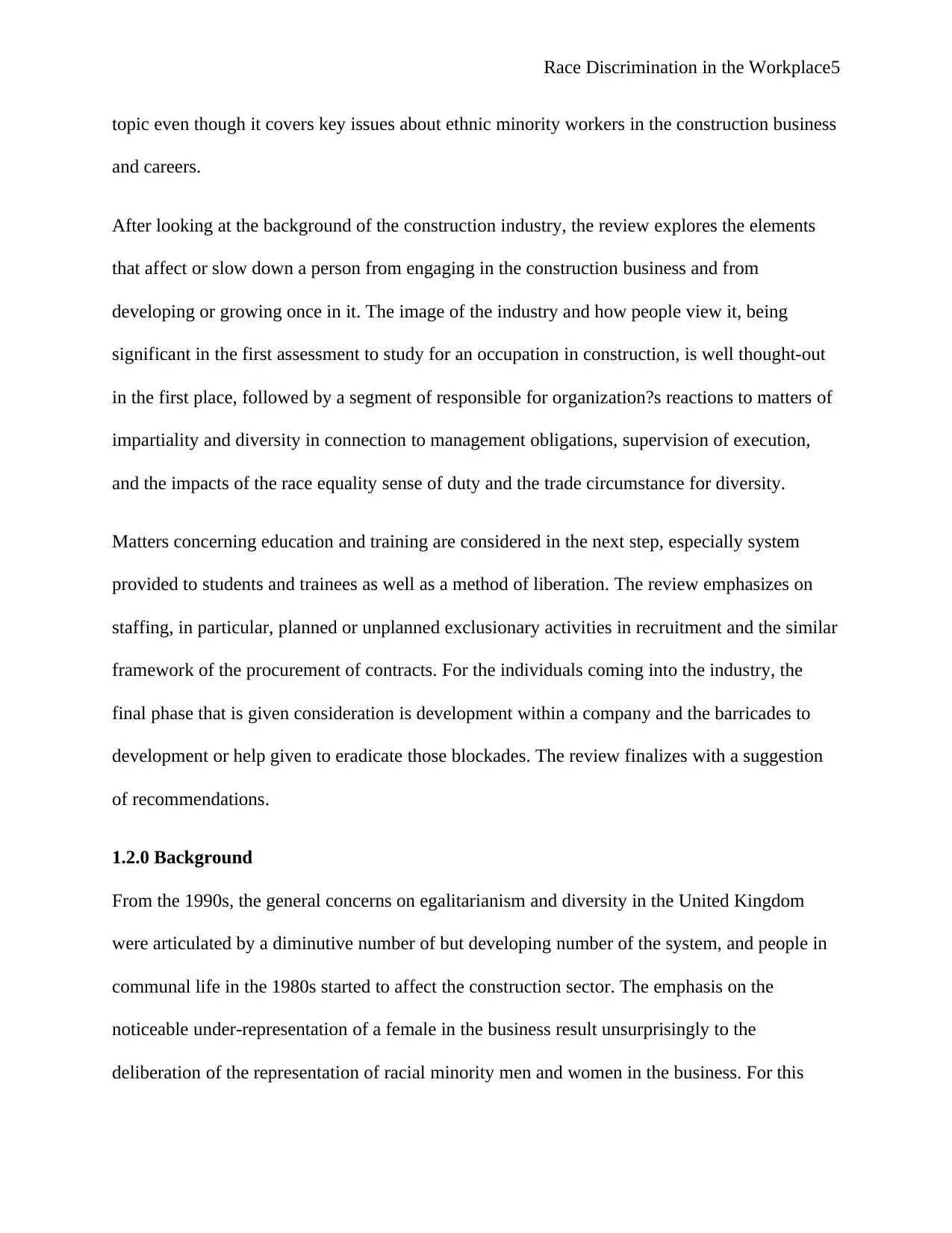
Race Discrimination in the Workplace5
topic even though it covers key issues about ethnic minority workers in the construction business
and careers.
After looking at the background of the construction industry, the review explores the elements
that affect or slow down a person from engaging in the construction business and from
developing or growing once in it. The image of the industry and how people view it, being
significant in the first assessment to study for an occupation in construction, is well thought-out
in the first place, followed by a segment of responsible for organization?s reactions to matters of
impartiality and diversity in connection to management obligations, supervision of execution,
and the impacts of the race equality sense of duty and the trade circumstance for diversity.
Matters concerning education and training are considered in the next step, especially system
provided to students and trainees as well as a method of liberation. The review emphasizes on
staffing, in particular, planned or unplanned exclusionary activities in recruitment and the similar
framework of the procurement of contracts. For the individuals coming into the industry, the
final phase that is given consideration is development within a company and the barricades to
development or help given to eradicate those blockades. The review finalizes with a suggestion
of recommendations.
1.2.0 Background
From the 1990s, the general concerns on egalitarianism and diversity in the United Kingdom
were articulated by a diminutive number of but developing number of the system, and people in
communal life in the 1980s started to affect the construction sector. The emphasis on the
noticeable under-representation of a female in the business result unsurprisingly to the
deliberation of the representation of racial minority men and women in the business. For this
topic even though it covers key issues about ethnic minority workers in the construction business
and careers.
After looking at the background of the construction industry, the review explores the elements
that affect or slow down a person from engaging in the construction business and from
developing or growing once in it. The image of the industry and how people view it, being
significant in the first assessment to study for an occupation in construction, is well thought-out
in the first place, followed by a segment of responsible for organization?s reactions to matters of
impartiality and diversity in connection to management obligations, supervision of execution,
and the impacts of the race equality sense of duty and the trade circumstance for diversity.
Matters concerning education and training are considered in the next step, especially system
provided to students and trainees as well as a method of liberation. The review emphasizes on
staffing, in particular, planned or unplanned exclusionary activities in recruitment and the similar
framework of the procurement of contracts. For the individuals coming into the industry, the
final phase that is given consideration is development within a company and the barricades to
development or help given to eradicate those blockades. The review finalizes with a suggestion
of recommendations.
1.2.0 Background
From the 1990s, the general concerns on egalitarianism and diversity in the United Kingdom
were articulated by a diminutive number of but developing number of the system, and people in
communal life in the 1980s started to affect the construction sector. The emphasis on the
noticeable under-representation of a female in the business result unsurprisingly to the
deliberation of the representation of racial minority men and women in the business. For this
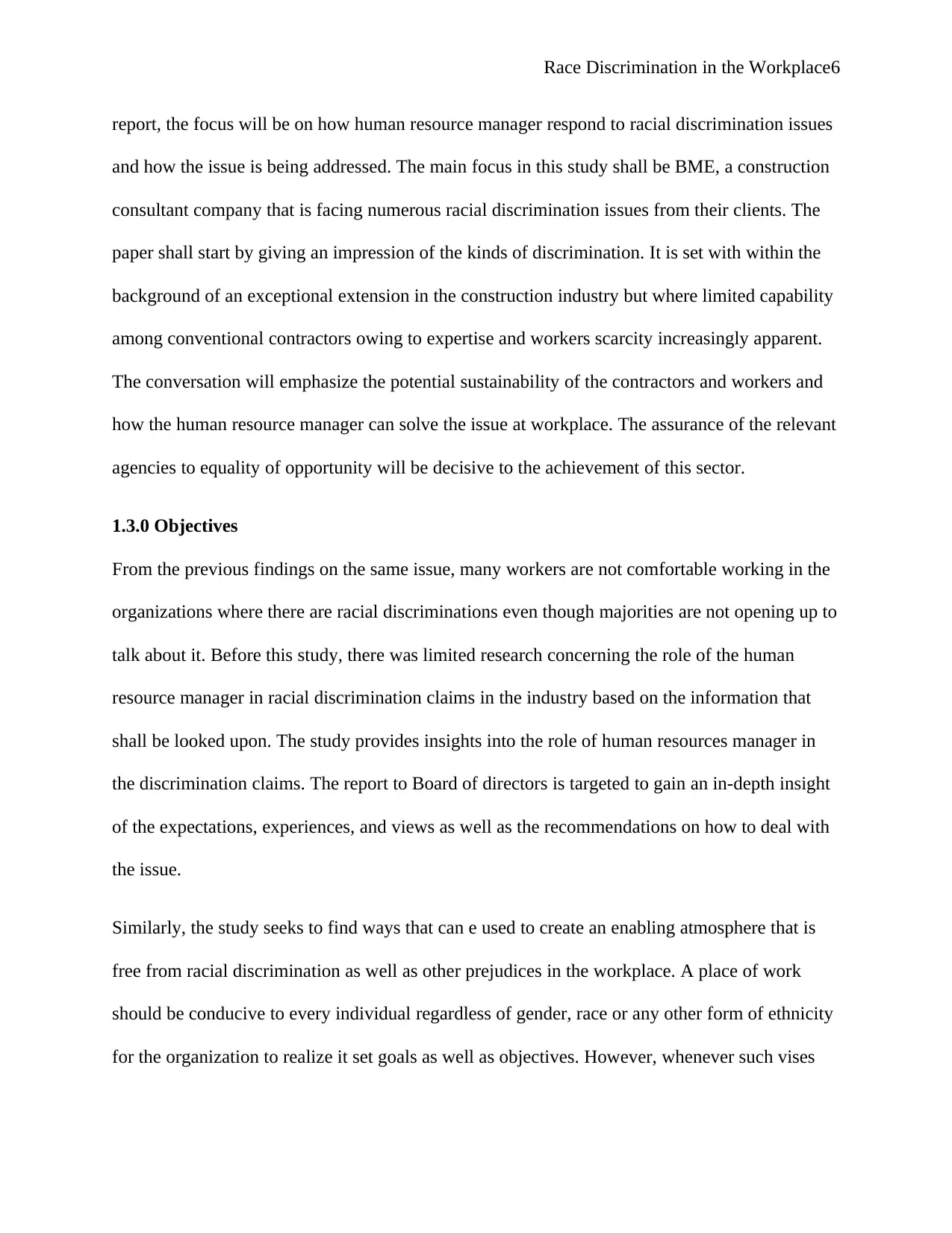
Race Discrimination in the Workplace6
report, the focus will be on how human resource manager respond to racial discrimination issues
and how the issue is being addressed. The main focus in this study shall be BME, a construction
consultant company that is facing numerous racial discrimination issues from their clients. The
paper shall start by giving an impression of the kinds of discrimination. It is set with within the
background of an exceptional extension in the construction industry but where limited capability
among conventional contractors owing to expertise and workers scarcity increasingly apparent.
The conversation will emphasize the potential sustainability of the contractors and workers and
how the human resource manager can solve the issue at workplace. The assurance of the relevant
agencies to equality of opportunity will be decisive to the achievement of this sector.
1.3.0 Objectives
From the previous findings on the same issue, many workers are not comfortable working in the
organizations where there are racial discriminations even though majorities are not opening up to
talk about it. Before this study, there was limited research concerning the role of the human
resource manager in racial discrimination claims in the industry based on the information that
shall be looked upon. The study provides insights into the role of human resources manager in
the discrimination claims. The report to Board of directors is targeted to gain an in-depth insight
of the expectations, experiences, and views as well as the recommendations on how to deal with
the issue.
Similarly, the study seeks to find ways that can e used to create an enabling atmosphere that is
free from racial discrimination as well as other prejudices in the workplace. A place of work
should be conducive to every individual regardless of gender, race or any other form of ethnicity
for the organization to realize it set goals as well as objectives. However, whenever such vises
report, the focus will be on how human resource manager respond to racial discrimination issues
and how the issue is being addressed. The main focus in this study shall be BME, a construction
consultant company that is facing numerous racial discrimination issues from their clients. The
paper shall start by giving an impression of the kinds of discrimination. It is set with within the
background of an exceptional extension in the construction industry but where limited capability
among conventional contractors owing to expertise and workers scarcity increasingly apparent.
The conversation will emphasize the potential sustainability of the contractors and workers and
how the human resource manager can solve the issue at workplace. The assurance of the relevant
agencies to equality of opportunity will be decisive to the achievement of this sector.
1.3.0 Objectives
From the previous findings on the same issue, many workers are not comfortable working in the
organizations where there are racial discriminations even though majorities are not opening up to
talk about it. Before this study, there was limited research concerning the role of the human
resource manager in racial discrimination claims in the industry based on the information that
shall be looked upon. The study provides insights into the role of human resources manager in
the discrimination claims. The report to Board of directors is targeted to gain an in-depth insight
of the expectations, experiences, and views as well as the recommendations on how to deal with
the issue.
Similarly, the study seeks to find ways that can e used to create an enabling atmosphere that is
free from racial discrimination as well as other prejudices in the workplace. A place of work
should be conducive to every individual regardless of gender, race or any other form of ethnicity
for the organization to realize it set goals as well as objectives. However, whenever such vises
⊘ This is a preview!⊘
Do you want full access?
Subscribe today to unlock all pages.

Trusted by 1+ million students worldwide
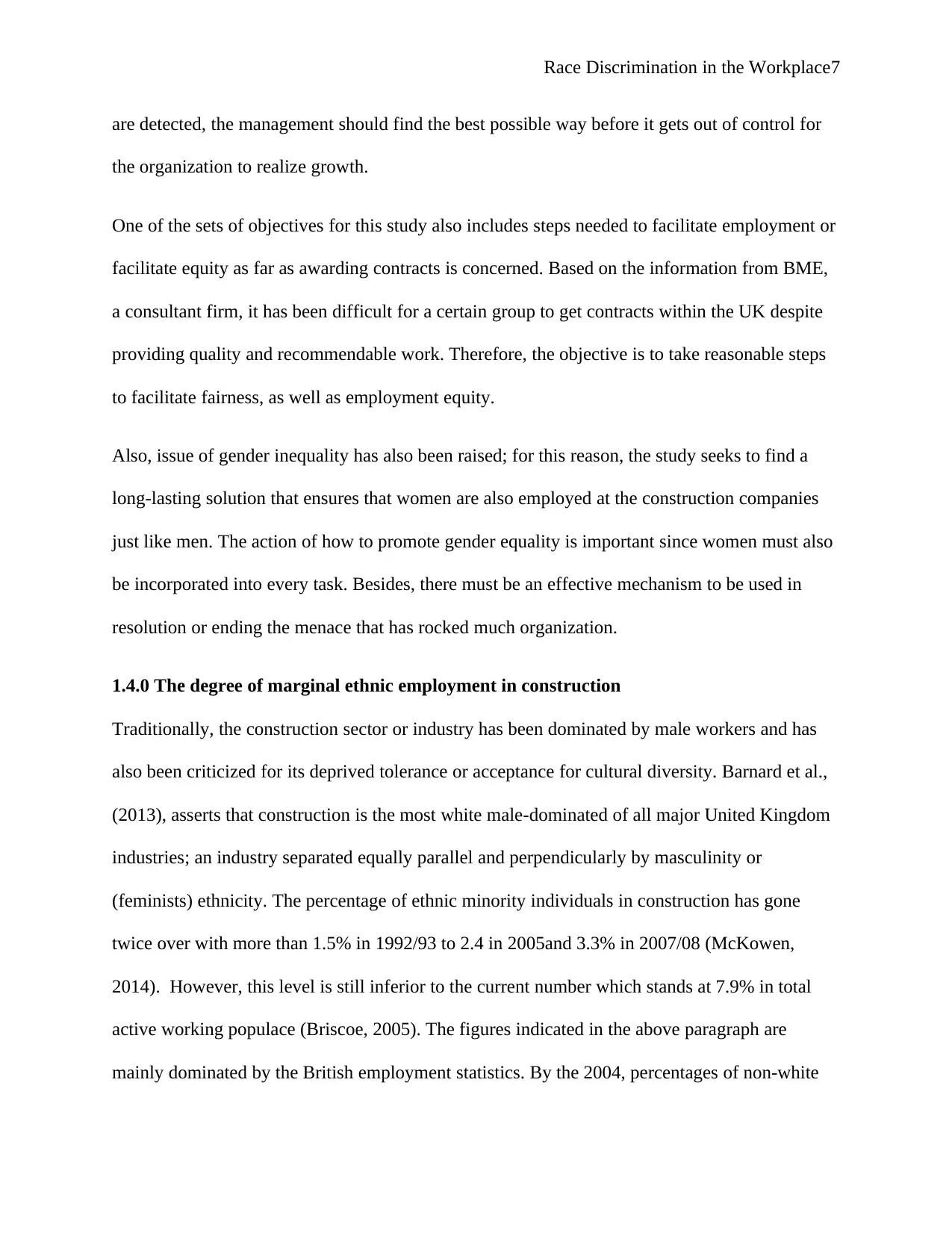
Race Discrimination in the Workplace7
are detected, the management should find the best possible way before it gets out of control for
the organization to realize growth.
One of the sets of objectives for this study also includes steps needed to facilitate employment or
facilitate equity as far as awarding contracts is concerned. Based on the information from BME,
a consultant firm, it has been difficult for a certain group to get contracts within the UK despite
providing quality and recommendable work. Therefore, the objective is to take reasonable steps
to facilitate fairness, as well as employment equity.
Also, issue of gender inequality has also been raised; for this reason, the study seeks to find a
long-lasting solution that ensures that women are also employed at the construction companies
just like men. The action of how to promote gender equality is important since women must also
be incorporated into every task. Besides, there must be an effective mechanism to be used in
resolution or ending the menace that has rocked much organization.
1.4.0 The degree of marginal ethnic employment in construction
Traditionally, the construction sector or industry has been dominated by male workers and has
also been criticized for its deprived tolerance or acceptance for cultural diversity. Barnard et al.,
(2013), asserts that construction is the most white male-dominated of all major United Kingdom
industries; an industry separated equally parallel and perpendicularly by masculinity or
(feminists) ethnicity. The percentage of ethnic minority individuals in construction has gone
twice over with more than 1.5% in 1992/93 to 2.4 in 2005and 3.3% in 2007/08 (McKowen,
2014). However, this level is still inferior to the current number which stands at 7.9% in total
active working populace (Briscoe, 2005). The figures indicated in the above paragraph are
mainly dominated by the British employment statistics. By the 2004, percentages of non-white
are detected, the management should find the best possible way before it gets out of control for
the organization to realize growth.
One of the sets of objectives for this study also includes steps needed to facilitate employment or
facilitate equity as far as awarding contracts is concerned. Based on the information from BME,
a consultant firm, it has been difficult for a certain group to get contracts within the UK despite
providing quality and recommendable work. Therefore, the objective is to take reasonable steps
to facilitate fairness, as well as employment equity.
Also, issue of gender inequality has also been raised; for this reason, the study seeks to find a
long-lasting solution that ensures that women are also employed at the construction companies
just like men. The action of how to promote gender equality is important since women must also
be incorporated into every task. Besides, there must be an effective mechanism to be used in
resolution or ending the menace that has rocked much organization.
1.4.0 The degree of marginal ethnic employment in construction
Traditionally, the construction sector or industry has been dominated by male workers and has
also been criticized for its deprived tolerance or acceptance for cultural diversity. Barnard et al.,
(2013), asserts that construction is the most white male-dominated of all major United Kingdom
industries; an industry separated equally parallel and perpendicularly by masculinity or
(feminists) ethnicity. The percentage of ethnic minority individuals in construction has gone
twice over with more than 1.5% in 1992/93 to 2.4 in 2005and 3.3% in 2007/08 (McKowen,
2014). However, this level is still inferior to the current number which stands at 7.9% in total
active working populace (Briscoe, 2005). The figures indicated in the above paragraph are
mainly dominated by the British employment statistics. By the 2004, percentages of non-white
Paraphrase This Document
Need a fresh take? Get an instant paraphrase of this document with our AI Paraphraser
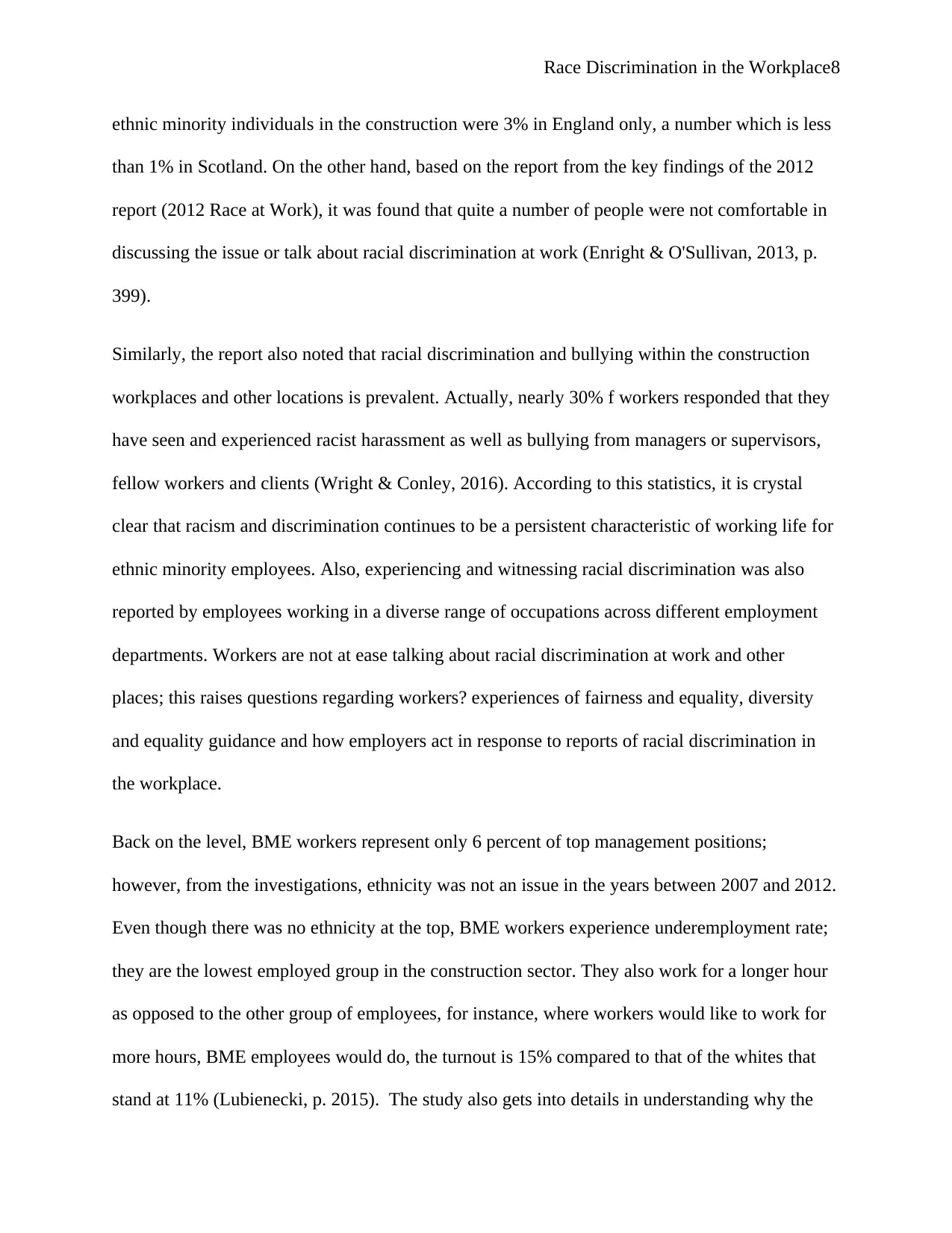
Race Discrimination in the Workplace8
ethnic minority individuals in the construction were 3% in England only, a number which is less
than 1% in Scotland. On the other hand, based on the report from the key findings of the 2012
report (2012 Race at Work), it was found that quite a number of people were not comfortable in
discussing the issue or talk about racial discrimination at work (Enright & O'Sullivan, 2013, p.
399).
Similarly, the report also noted that racial discrimination and bullying within the construction
workplaces and other locations is prevalent. Actually, nearly 30% f workers responded that they
have seen and experienced racist harassment as well as bullying from managers or supervisors,
fellow workers and clients (Wright & Conley, 2016). According to this statistics, it is crystal
clear that racism and discrimination continues to be a persistent characteristic of working life for
ethnic minority employees. Also, experiencing and witnessing racial discrimination was also
reported by employees working in a diverse range of occupations across different employment
departments. Workers are not at ease talking about racial discrimination at work and other
places; this raises questions regarding workers? experiences of fairness and equality, diversity
and equality guidance and how employers act in response to reports of racial discrimination in
the workplace.
Back on the level, BME workers represent only 6 percent of top management positions;
however, from the investigations, ethnicity was not an issue in the years between 2007 and 2012.
Even though there was no ethnicity at the top, BME workers experience underemployment rate;
they are the lowest employed group in the construction sector. They also work for a longer hour
as opposed to the other group of employees, for instance, where workers would like to work for
more hours, BME employees would do, the turnout is 15% compared to that of the whites that
stand at 11% (Lubienecki, p. 2015). The study also gets into details in understanding why the
ethnic minority individuals in the construction were 3% in England only, a number which is less
than 1% in Scotland. On the other hand, based on the report from the key findings of the 2012
report (2012 Race at Work), it was found that quite a number of people were not comfortable in
discussing the issue or talk about racial discrimination at work (Enright & O'Sullivan, 2013, p.
399).
Similarly, the report also noted that racial discrimination and bullying within the construction
workplaces and other locations is prevalent. Actually, nearly 30% f workers responded that they
have seen and experienced racist harassment as well as bullying from managers or supervisors,
fellow workers and clients (Wright & Conley, 2016). According to this statistics, it is crystal
clear that racism and discrimination continues to be a persistent characteristic of working life for
ethnic minority employees. Also, experiencing and witnessing racial discrimination was also
reported by employees working in a diverse range of occupations across different employment
departments. Workers are not at ease talking about racial discrimination at work and other
places; this raises questions regarding workers? experiences of fairness and equality, diversity
and equality guidance and how employers act in response to reports of racial discrimination in
the workplace.
Back on the level, BME workers represent only 6 percent of top management positions;
however, from the investigations, ethnicity was not an issue in the years between 2007 and 2012.
Even though there was no ethnicity at the top, BME workers experience underemployment rate;
they are the lowest employed group in the construction sector. They also work for a longer hour
as opposed to the other group of employees, for instance, where workers would like to work for
more hours, BME employees would do, the turnout is 15% compared to that of the whites that
stand at 11% (Lubienecki, p. 2015). The study also gets into details in understanding why the
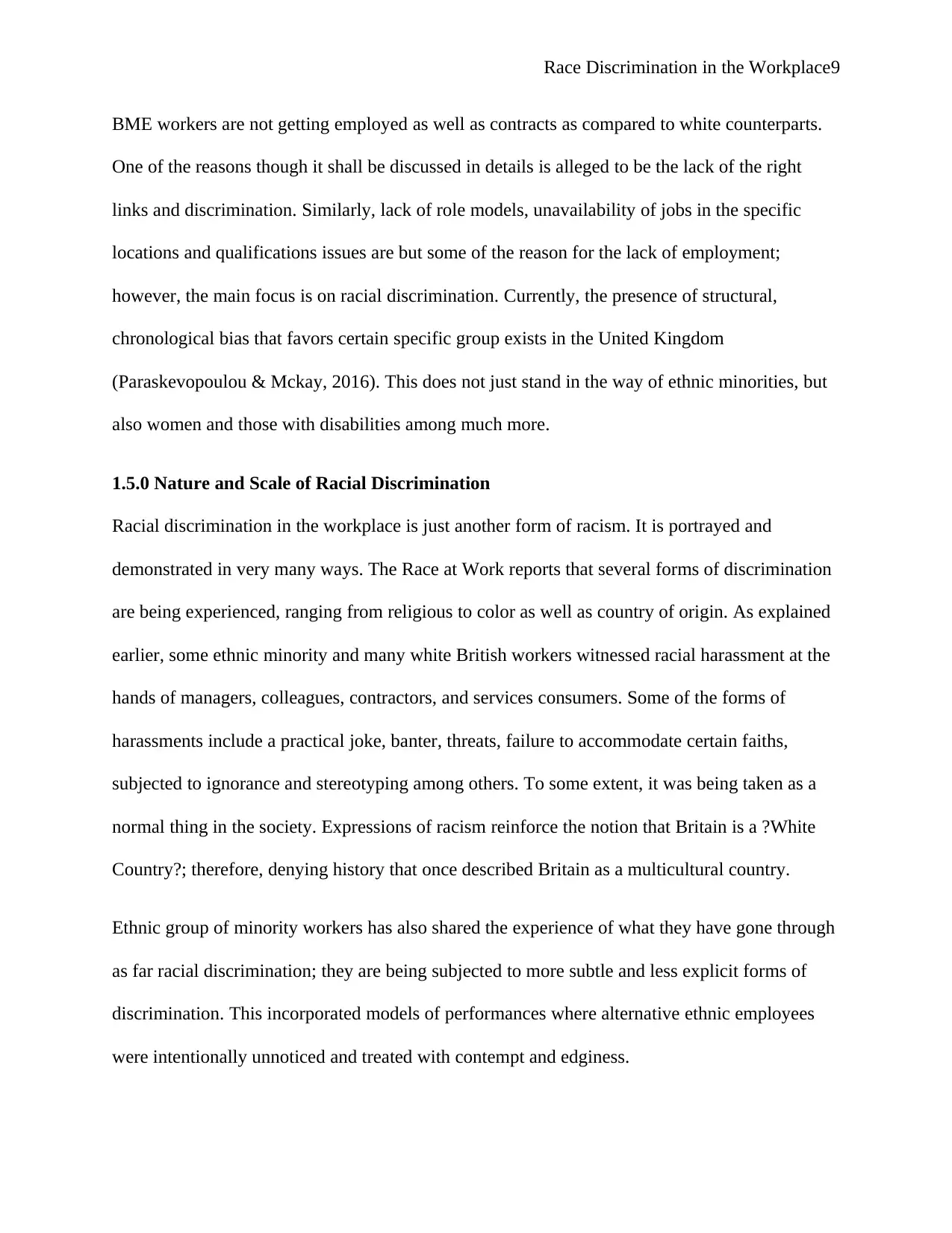
Race Discrimination in the Workplace9
BME workers are not getting employed as well as contracts as compared to white counterparts.
One of the reasons though it shall be discussed in details is alleged to be the lack of the right
links and discrimination. Similarly, lack of role models, unavailability of jobs in the specific
locations and qualifications issues are but some of the reason for the lack of employment;
however, the main focus is on racial discrimination. Currently, the presence of structural,
chronological bias that favors certain specific group exists in the United Kingdom
(Paraskevopoulou & Mckay, 2016). This does not just stand in the way of ethnic minorities, but
also women and those with disabilities among much more.
1.5.0 Nature and Scale of Racial Discrimination
Racial discrimination in the workplace is just another form of racism. It is portrayed and
demonstrated in very many ways. The Race at Work reports that several forms of discrimination
are being experienced, ranging from religious to color as well as country of origin. As explained
earlier, some ethnic minority and many white British workers witnessed racial harassment at the
hands of managers, colleagues, contractors, and services consumers. Some of the forms of
harassments include a practical joke, banter, threats, failure to accommodate certain faiths,
subjected to ignorance and stereotyping among others. To some extent, it was being taken as a
normal thing in the society. Expressions of racism reinforce the notion that Britain is a ?White
Country?; therefore, denying history that once described Britain as a multicultural country.
Ethnic group of minority workers has also shared the experience of what they have gone through
as far racial discrimination; they are being subjected to more subtle and less explicit forms of
discrimination. This incorporated models of performances where alternative ethnic employees
were intentionally unnoticed and treated with contempt and edginess.
BME workers are not getting employed as well as contracts as compared to white counterparts.
One of the reasons though it shall be discussed in details is alleged to be the lack of the right
links and discrimination. Similarly, lack of role models, unavailability of jobs in the specific
locations and qualifications issues are but some of the reason for the lack of employment;
however, the main focus is on racial discrimination. Currently, the presence of structural,
chronological bias that favors certain specific group exists in the United Kingdom
(Paraskevopoulou & Mckay, 2016). This does not just stand in the way of ethnic minorities, but
also women and those with disabilities among much more.
1.5.0 Nature and Scale of Racial Discrimination
Racial discrimination in the workplace is just another form of racism. It is portrayed and
demonstrated in very many ways. The Race at Work reports that several forms of discrimination
are being experienced, ranging from religious to color as well as country of origin. As explained
earlier, some ethnic minority and many white British workers witnessed racial harassment at the
hands of managers, colleagues, contractors, and services consumers. Some of the forms of
harassments include a practical joke, banter, threats, failure to accommodate certain faiths,
subjected to ignorance and stereotyping among others. To some extent, it was being taken as a
normal thing in the society. Expressions of racism reinforce the notion that Britain is a ?White
Country?; therefore, denying history that once described Britain as a multicultural country.
Ethnic group of minority workers has also shared the experience of what they have gone through
as far racial discrimination; they are being subjected to more subtle and less explicit forms of
discrimination. This incorporated models of performances where alternative ethnic employees
were intentionally unnoticed and treated with contempt and edginess.
⊘ This is a preview!⊘
Do you want full access?
Subscribe today to unlock all pages.

Trusted by 1+ million students worldwide
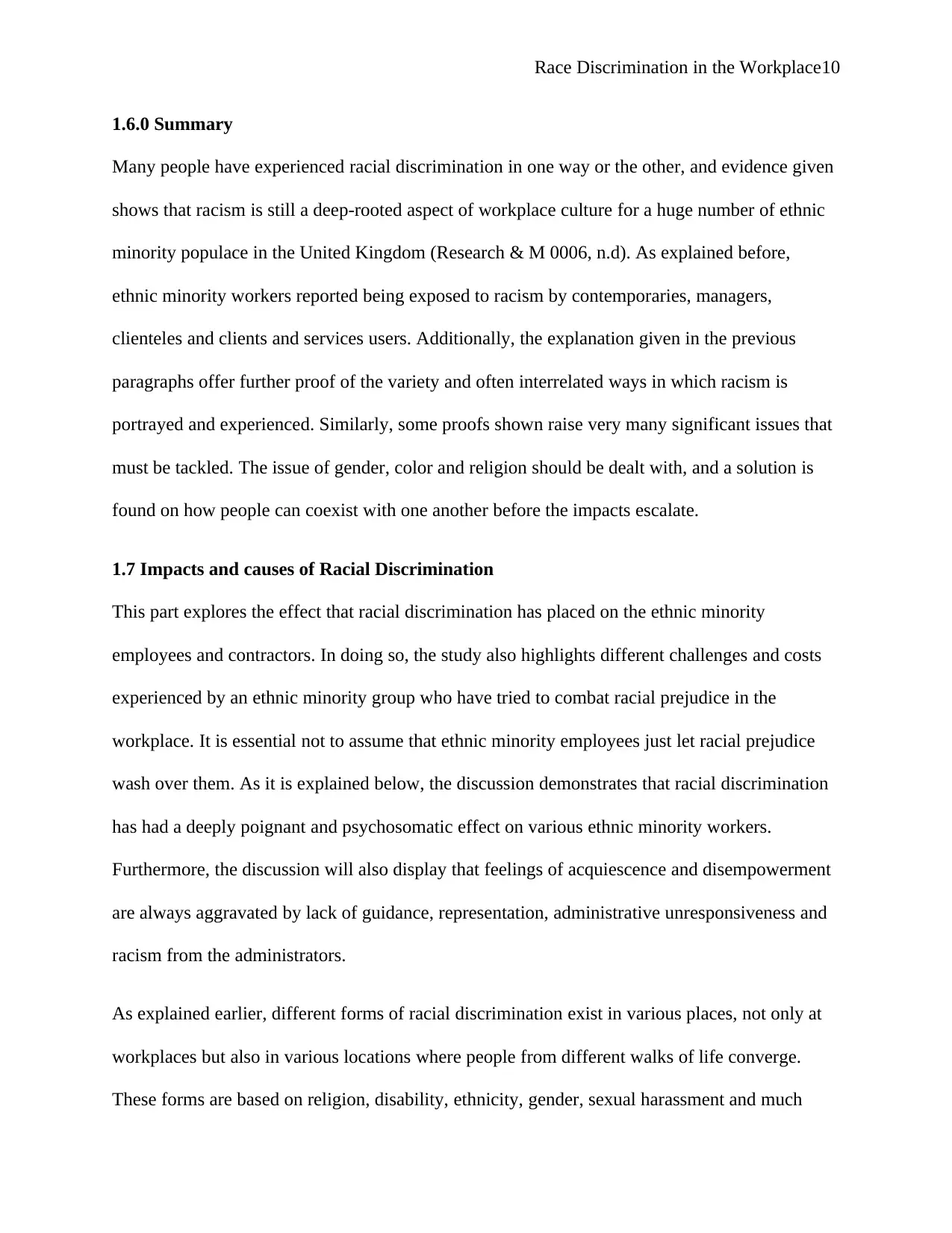
Race Discrimination in the Workplace10
1.6.0 Summary
Many people have experienced racial discrimination in one way or the other, and evidence given
shows that racism is still a deep-rooted aspect of workplace culture for a huge number of ethnic
minority populace in the United Kingdom (Research & M 0006, n.d). As explained before,
ethnic minority workers reported being exposed to racism by contemporaries, managers,
clienteles and clients and services users. Additionally, the explanation given in the previous
paragraphs offer further proof of the variety and often interrelated ways in which racism is
portrayed and experienced. Similarly, some proofs shown raise very many significant issues that
must be tackled. The issue of gender, color and religion should be dealt with, and a solution is
found on how people can coexist with one another before the impacts escalate.
1.7 Impacts and causes of Racial Discrimination
This part explores the effect that racial discrimination has placed on the ethnic minority
employees and contractors. In doing so, the study also highlights different challenges and costs
experienced by an ethnic minority group who have tried to combat racial prejudice in the
workplace. It is essential not to assume that ethnic minority employees just let racial prejudice
wash over them. As it is explained below, the discussion demonstrates that racial discrimination
has had a deeply poignant and psychosomatic effect on various ethnic minority workers.
Furthermore, the discussion will also display that feelings of acquiescence and disempowerment
are always aggravated by lack of guidance, representation, administrative unresponsiveness and
racism from the administrators.
As explained earlier, different forms of racial discrimination exist in various places, not only at
workplaces but also in various locations where people from different walks of life converge.
These forms are based on religion, disability, ethnicity, gender, sexual harassment and much
1.6.0 Summary
Many people have experienced racial discrimination in one way or the other, and evidence given
shows that racism is still a deep-rooted aspect of workplace culture for a huge number of ethnic
minority populace in the United Kingdom (Research & M 0006, n.d). As explained before,
ethnic minority workers reported being exposed to racism by contemporaries, managers,
clienteles and clients and services users. Additionally, the explanation given in the previous
paragraphs offer further proof of the variety and often interrelated ways in which racism is
portrayed and experienced. Similarly, some proofs shown raise very many significant issues that
must be tackled. The issue of gender, color and religion should be dealt with, and a solution is
found on how people can coexist with one another before the impacts escalate.
1.7 Impacts and causes of Racial Discrimination
This part explores the effect that racial discrimination has placed on the ethnic minority
employees and contractors. In doing so, the study also highlights different challenges and costs
experienced by an ethnic minority group who have tried to combat racial prejudice in the
workplace. It is essential not to assume that ethnic minority employees just let racial prejudice
wash over them. As it is explained below, the discussion demonstrates that racial discrimination
has had a deeply poignant and psychosomatic effect on various ethnic minority workers.
Furthermore, the discussion will also display that feelings of acquiescence and disempowerment
are always aggravated by lack of guidance, representation, administrative unresponsiveness and
racism from the administrators.
As explained earlier, different forms of racial discrimination exist in various places, not only at
workplaces but also in various locations where people from different walks of life converge.
These forms are based on religion, disability, ethnicity, gender, sexual harassment and much
Paraphrase This Document
Need a fresh take? Get an instant paraphrase of this document with our AI Paraphraser
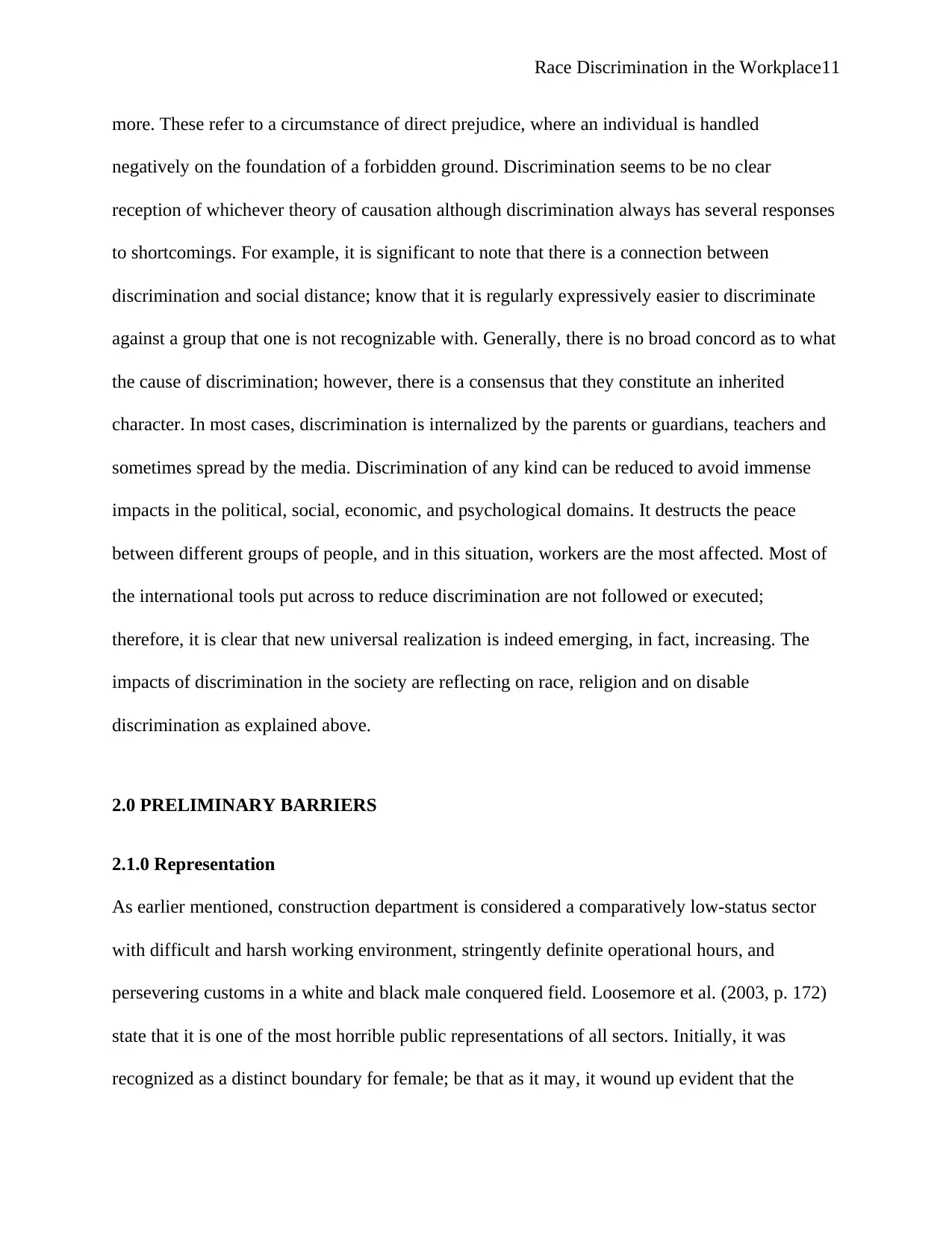
Race Discrimination in the Workplace11
more. These refer to a circumstance of direct prejudice, where an individual is handled
negatively on the foundation of a forbidden ground. Discrimination seems to be no clear
reception of whichever theory of causation although discrimination always has several responses
to shortcomings. For example, it is significant to note that there is a connection between
discrimination and social distance; know that it is regularly expressively easier to discriminate
against a group that one is not recognizable with. Generally, there is no broad concord as to what
the cause of discrimination; however, there is a consensus that they constitute an inherited
character. In most cases, discrimination is internalized by the parents or guardians, teachers and
sometimes spread by the media. Discrimination of any kind can be reduced to avoid immense
impacts in the political, social, economic, and psychological domains. It destructs the peace
between different groups of people, and in this situation, workers are the most affected. Most of
the international tools put across to reduce discrimination are not followed or executed;
therefore, it is clear that new universal realization is indeed emerging, in fact, increasing. The
impacts of discrimination in the society are reflecting on race, religion and on disable
discrimination as explained above.
2.0 PRELIMINARY BARRIERS
2.1.0 Representation
As earlier mentioned, construction department is considered a comparatively low-status sector
with difficult and harsh working environment, stringently definite operational hours, and
persevering customs in a white and black male conquered field. Loosemore et al. (2003, p. 172)
state that it is one of the most horrible public representations of all sectors. Initially, it was
recognized as a distinct boundary for female; be that as it may, it wound up evident that the
more. These refer to a circumstance of direct prejudice, where an individual is handled
negatively on the foundation of a forbidden ground. Discrimination seems to be no clear
reception of whichever theory of causation although discrimination always has several responses
to shortcomings. For example, it is significant to note that there is a connection between
discrimination and social distance; know that it is regularly expressively easier to discriminate
against a group that one is not recognizable with. Generally, there is no broad concord as to what
the cause of discrimination; however, there is a consensus that they constitute an inherited
character. In most cases, discrimination is internalized by the parents or guardians, teachers and
sometimes spread by the media. Discrimination of any kind can be reduced to avoid immense
impacts in the political, social, economic, and psychological domains. It destructs the peace
between different groups of people, and in this situation, workers are the most affected. Most of
the international tools put across to reduce discrimination are not followed or executed;
therefore, it is clear that new universal realization is indeed emerging, in fact, increasing. The
impacts of discrimination in the society are reflecting on race, religion and on disable
discrimination as explained above.
2.0 PRELIMINARY BARRIERS
2.1.0 Representation
As earlier mentioned, construction department is considered a comparatively low-status sector
with difficult and harsh working environment, stringently definite operational hours, and
persevering customs in a white and black male conquered field. Loosemore et al. (2003, p. 172)
state that it is one of the most horrible public representations of all sectors. Initially, it was
recognized as a distinct boundary for female; be that as it may, it wound up evident that the
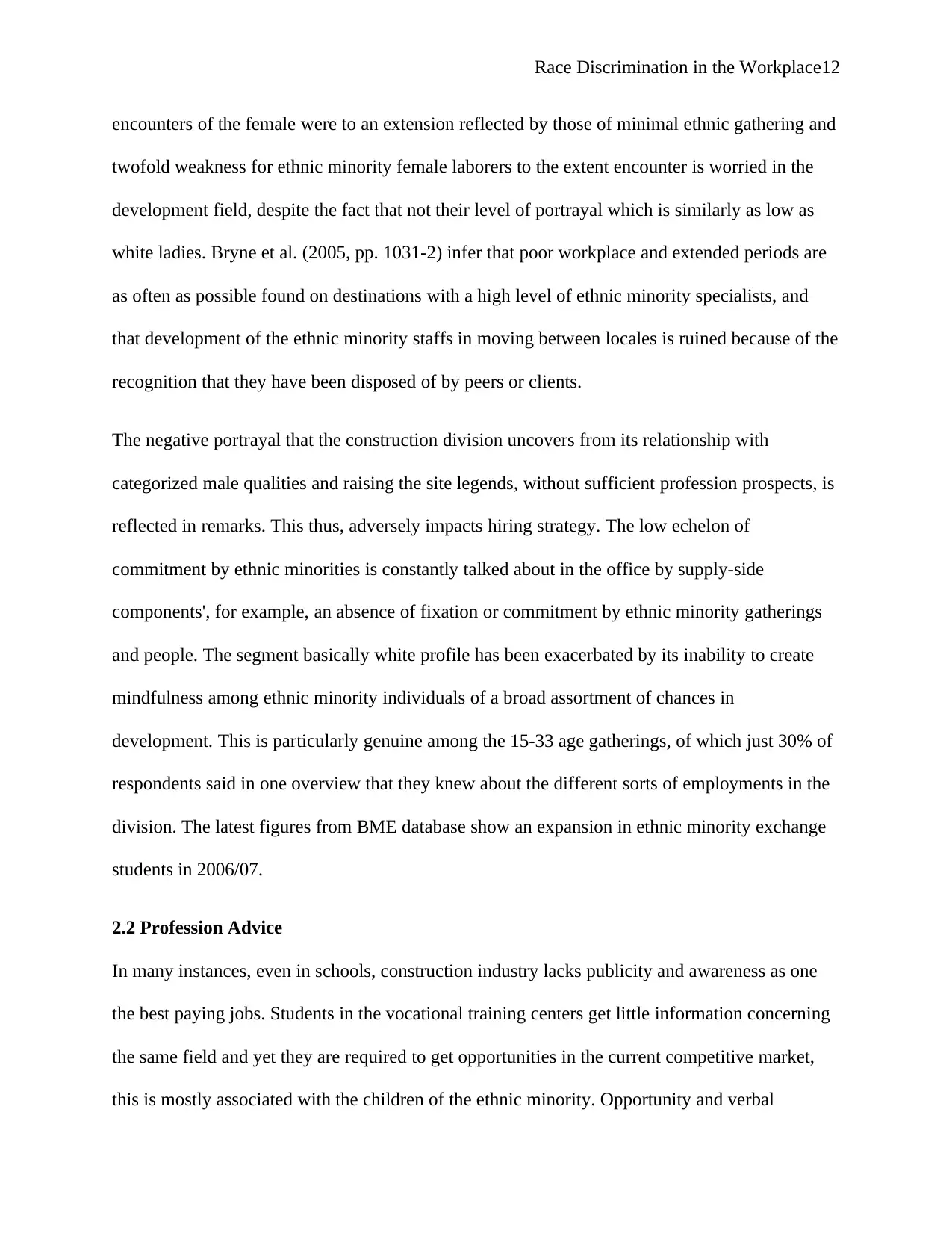
Race Discrimination in the Workplace12
encounters of the female were to an extension reflected by those of minimal ethnic gathering and
twofold weakness for ethnic minority female laborers to the extent encounter is worried in the
development field, despite the fact that not their level of portrayal which is similarly as low as
white ladies. Bryne et al. (2005, pp. 1031-2) infer that poor workplace and extended periods are
as often as possible found on destinations with a high level of ethnic minority specialists, and
that development of the ethnic minority staffs in moving between locales is ruined because of the
recognition that they have been disposed of by peers or clients.
The negative portrayal that the construction division uncovers from its relationship with
categorized male qualities and raising the site legends, without sufficient profession prospects, is
reflected in remarks. This thus, adversely impacts hiring strategy. The low echelon of
commitment by ethnic minorities is constantly talked about in the office by supply-side
components', for example, an absence of fixation or commitment by ethnic minority gatherings
and people. The segment basically white profile has been exacerbated by its inability to create
mindfulness among ethnic minority individuals of a broad assortment of chances in
development. This is particularly genuine among the 15-33 age gatherings, of which just 30% of
respondents said in one overview that they knew about the different sorts of employments in the
division. The latest figures from BME database show an expansion in ethnic minority exchange
students in 2006/07.
2.2 Profession Advice
In many instances, even in schools, construction industry lacks publicity and awareness as one
the best paying jobs. Students in the vocational training centers get little information concerning
the same field and yet they are required to get opportunities in the current competitive market,
this is mostly associated with the children of the ethnic minority. Opportunity and verbal
encounters of the female were to an extension reflected by those of minimal ethnic gathering and
twofold weakness for ethnic minority female laborers to the extent encounter is worried in the
development field, despite the fact that not their level of portrayal which is similarly as low as
white ladies. Bryne et al. (2005, pp. 1031-2) infer that poor workplace and extended periods are
as often as possible found on destinations with a high level of ethnic minority specialists, and
that development of the ethnic minority staffs in moving between locales is ruined because of the
recognition that they have been disposed of by peers or clients.
The negative portrayal that the construction division uncovers from its relationship with
categorized male qualities and raising the site legends, without sufficient profession prospects, is
reflected in remarks. This thus, adversely impacts hiring strategy. The low echelon of
commitment by ethnic minorities is constantly talked about in the office by supply-side
components', for example, an absence of fixation or commitment by ethnic minority gatherings
and people. The segment basically white profile has been exacerbated by its inability to create
mindfulness among ethnic minority individuals of a broad assortment of chances in
development. This is particularly genuine among the 15-33 age gatherings, of which just 30% of
respondents said in one overview that they knew about the different sorts of employments in the
division. The latest figures from BME database show an expansion in ethnic minority exchange
students in 2006/07.
2.2 Profession Advice
In many instances, even in schools, construction industry lacks publicity and awareness as one
the best paying jobs. Students in the vocational training centers get little information concerning
the same field and yet they are required to get opportunities in the current competitive market,
this is mostly associated with the children of the ethnic minority. Opportunity and verbal
⊘ This is a preview!⊘
Do you want full access?
Subscribe today to unlock all pages.

Trusted by 1+ million students worldwide
1 out of 23
Related Documents
Your All-in-One AI-Powered Toolkit for Academic Success.
+13062052269
info@desklib.com
Available 24*7 on WhatsApp / Email
![[object Object]](/_next/static/media/star-bottom.7253800d.svg)
Unlock your academic potential
Copyright © 2020–2025 A2Z Services. All Rights Reserved. Developed and managed by ZUCOL.



